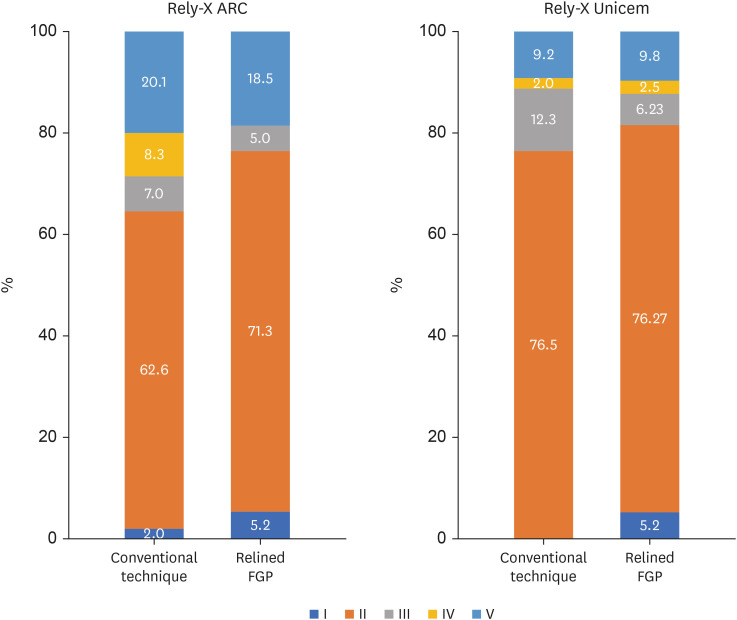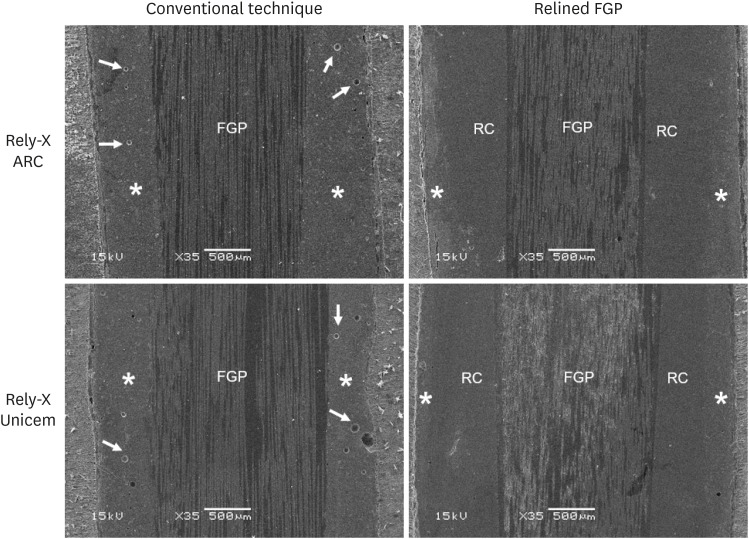Restor Dent Endod.
2024 May;49(2):e18. 10.5395/rde.2024.49.e18.
Effects of a relined fiberglass post with conventional and self-adhesive resin cement
- Affiliations
-
- 1Operative Dentistry Division, Department of Restorative Dentistry, Piracicaba Dental School, University of Campinas, Piracicaba, Brazil
- 2Operative Dentistry Division, Department of Restorative Dentistry, School of Dentistry, Federal University of Alagoas, Campus A. C. Simões, Maceió, Alagoas, Brazil
- KMID: 2556547
- DOI: http://doi.org/10.5395/rde.2024.49.e18
Abstract
Objectives
This study was conducted to evaluate the mechanical properties of relined and non-relined fiberglass posts when cemented to root canal dentin using a conventional dualcure resin cement or a self-adhesive resin cement.
Materials and Methods
Two types of resin cements were utilized: conventional and selfadhesive. Additionally, 2 cementation protocols were employed, involving relined and non-relined fiberglass posts. In total, 72 bovine incisors were cemented and subjected to push-out bond strength testing (n = 10) followed by failure mode analysis. The cross-sectional microhardness (n = 5) was assessed along the root canal, and interface analyses (n = 3) were conducted using scanning electron microscopy (SEM). Data from the push-out bond strength and cross-sectional microhardness tests were analyzed via 3-way analysis of variance and the Bonferroni post-hoc test (α = 0.05).
Results
For non-relined fiberglass posts, conventional resin cement exhibited higher pushout bond strength than self-adhesive cement. Relined fiberglass posts yielded comparable results between the resin cements. Type II failure was the most common failure mode for both resin cements, regardless of cementation protocol. The use of relined fiberglass posts improved the cross-sectional microhardness values for both cements. SEM images revealed voids and bubbles in the incisors with non-relined fiberglass posts.
Conclusions
Mechanical properties were impacted by the cementation protocol. Relined fiberglass posts presented the highest push-out bond strength and cross-sectional microhardness values, regardless of the resin cement used (conventional dual-cure or selfadhesive). Conversely, for non-relined fiberglass posts, the conventional dual-cure resin cement yielded superior results to the self-adhesive resin cement.
Keyword
Figure
Reference
-
1. Shafiei F, Mohammadparast P, Jowkar Z. Adhesion performance of a universal adhesive in the root canal: effect of etch-and-rinse vs. self-etch mode. PLoS One. 2018; 13:e0195367. PMID: 29630636.2. Machry RV, Fontana PE, Bohrer TC, Valandro LF, Kaizer OB. Effect of different surface treatments of resin relined fiber posts cemented with self-adhesive resin cement on push-out and microtensile bond strength tests. Oper Dent. 2020; 45:E185–E195. PMID: 32216727.3. Silva GR, Santos-Filho PC, Simamoto-Júnior PC, Martins LR, Mota AS, Soares CJ. Effect of post type and restorative techniques on the strain and fracture resistance of flared incisor roots. Braz Dent J. 2011; 22:230–237. PMID: 21915521.4. Silva CF, Cabral LC, Navarro de Oliveira M, da Mota Martins V, Machado AC, Blumenberg C, et al. The influence of customization of glass fiber posts on fracture strength and failure pattern: a systematic review and meta-analysis of preclinical ex-vivo studies. J Mech Behav Biomed Mater. 2021; 118:104433. PMID: 33684707.5. Rodrigues RV, Sampaio CS, Pacheco RR, Pascon FM, Puppin-Rontani RM, Giannini M. Influence of adhesive cementation systems on the bond strength of relined fiber posts to root dentin. J Prosthet Dent. 2017; 118:493–499. PMID: 28343677.6. Marchionatti AM, Wandscher VF, Rippe MP, Kaizer OB, Valandro LF. Clinical performance and failure modes of pulpless teeth restored with posts: a systematic review. Braz Oral Res. 2017; 31:e64. PMID: 28678974.7. Parčina Amižić I, Baraba A, Ionescu AC, Brambilla E, Van Ende A, Miletić I. Bond strength of individually formed and prefabricated fiber-reinforced composite posts. J Adhes Dent. 2019; 21:557–565. PMID: 31802072.8. Freitas TL, Vitti RP, Miranda ME, Brandt WC. Effect of glass fiber post adaptation on push-out bond strength to root dentin. Braz Dent J. 2019; 30:350–355. PMID: 31340224.9. Leandrin TP, Fernández E, Lima RO, Besegato JF, Escalante-Otárola WG, Kuga MC. Customized fiber post improves the bond strength and dentinal penetrability of resin cementation system to root dentin. Oper Dent. 2022; 47:E22–E34. PMID: 34969119.10. Jurema AL, Filgueiras AT, Santos KA, Bresciani E, Caneppele TM. Effect of intraradicular fiber post on the fracture resistance of endodontically treated and restored anterior teeth: a systematic review and meta-analysis. J Prosthet Dent. 2022; 128:13–24. PMID: 33546858.11. Hoshino IA, Dos Santos PH, Briso AL, Sundfeld RH, Yamaguchi S, Rocha EP, et al. Biomechanical performance of three fiberglass post cementation techniques: Imaging, in vitro, and in silico analysis. J Prosthodont Res. 2023; 67:103–111. PMID: 35264548.12. Souza NC, Marcondes ML, Breda RV, Weber JB, Mota EG, Spohr AM. Relined fiberglass post: an ex vivo study of the resin cement thickness and dentin-resin interface. Braz Oral Res. 2016; 30:S1806–S83242016000100274.13. Lins RB, Cordeiro JM, Rangel CP, Antunes TB, Martins LR. The effect of individualization of fiberglass posts using bulk-fill resin-based composites on cementation: an in vitro study. Restor Dent Endod. 2019; 44:e37. PMID: 31799165.14. Pan Y, Xu X, Sun F, Meng X. Surface morphology and mechanical properties of conventional and self-adhesive resin cements after aqueous aging. J Appl Oral Sci. 2018; 27:e20170449. PMID: 30427472.15. Karakis D, Yıldırım-Bicer AZ, Dogan A, Koralay H, Cavdar S. Effect of self and dual-curing on degree of conversion and crosslink density of dual-cure core build-up materials. J Prosthodont Res. 2017; 61:210–216. PMID: 27717749.16. Hitz T, Stawarczyk B, Fischer J, Hämmerle CH, Sailer I. Are self-adhesive resin cements a valid alternative to conventional resin cements? A laboratory study of the long-term bond strength. Dent Mater. 2012; 28:1183–1190. PMID: 22999370.17. Roesner AJ, Schmohl L, Hahnel S, Fuchs F, König A, Rauch A. Acid resistance of self-adhesive resin luting cements - changes in surface texture parameters and microhardness. Dent Mater. 2022; 38:1376–1384. PMID: 35773036.18. Wang C, Fang Y, Zhang L, Su Z, Xu J, Fu B. Enamel microstructural features of bovine and human incisors: a comparative study. Ann Anat. 2021; 235:151700. PMID: 33588042.19. Pedreira AP, Pegoraro LF, de Góes MF, Pegoraro TA, Carvalho RM. Microhardness of resin cements in the intraradicular environment: effects of water storage and softening treament. Dent Mater. 2009; 25:868–876. PMID: 19217152.20. Grandini S, Goracci C, Monticelli F, Borracchini A, Ferrari M. SEM evaluation of the cement layer thickness after luting two different posts. J Adhes Dent. 2005; 7:235–240. PMID: 16240965.21. Gomes GM, Gomes OM, Reis A, Gomes JC, Loguercio AD, Calixto AL. Effect of operator experience on the outcome of fiber post cementation with different resin cements. Oper Dent. 2013; 38:555–564. PMID: 23216469.22. Manso AP, Carvalho RM. Dental cements for luting and bonding restorations: self-adhesive resin cements. Dent Clin North Am. 2017; 61:821–834. PMID: 28886770.23. Zorzin J, Petschelt A, Ebert J, Lohbauer U. pH neutralization and influence on mechanical strength in self-adhesive resin luting agents. Dent Mater. 2012; 28:672–679. PMID: 22464870.24. Faria-e-Silva AL, Menezes MS, Silva FP, Reis GR, Moraes RR. Intra-radicular dentin treatments and retention of fiber posts with self-adhesive resin cements. Braz Oral Res. 2013; 27:14–19. PMID: 23306622.25. Moazzami SM, Kazemi R, Alami M, Attaran E, Mehhary M, Sarmad M, et al. Light conduction capability of different light-transmitting FRC posts. J Dent Mater Tech. 2012; 1:40–46.26. Caughman WF, Chan DC, Rueggeberg FA. Curing potential of dual-polymerizable resin cements in simulated clinical situations. J Prosthet Dent. 2001; 85:479–484. PMID: 11357075.27. Ramos MB, Pegoraro TA, Pegoraro LF, Carvalho RM. Effects of curing protocol and storage time on the micro-hardness of resin cements used to lute fiber-reinforced resin posts. J Appl Oral Sci. 2012; 20:556–562. PMID: 23138743.28. Başaran G, Göncü Başaran E, Ayna E, Değer Y, Ayna B, Tuncer MC. Microtensile bond strength of root canal dentin treated with adhesive and fiber-reinforced post systems. Braz Oral Res. 2019; 33:e027. PMID: 31269112.29. Bell-Rönnlöf AL, Jaatinen J, Lassila L, Närhi T, Vallittu P. Transmission of light through fiber-reinforced composite posts. Dent Mater J. 2019; 38:928–933. PMID: 31406094.30. Haralur SB, Alasmari TA, Alasmari MH, Hakami HM. Light transmission of various aesthetic posts at different depths and its effect on push-out bond strength, microhardness of luting cement. Medicina (Kaunas). 2022; 58:75. PMID: 35056383.31. Kim KH, Ong JL, Okuno O. The effect of filler loading and morphology on the mechanical properties of contemporary composites. J Prosthet Dent. 2002; 87:642–649. PMID: 12131887.32. Karakis D, Yıldırım-Bicer AZ, Dogan A, Koralay H, Cavdar S. Effect of self and dual-curing on degree of conversion and crosslink density of dual-cure core build-up materials. J Prosthodont Res. 2017; 61:210–216. PMID: 27717749.33. Lacerda FC, Vieira-Junior WF, de Lacerda PE, Turssi CP, Basting RT, do Amaral FL, et al. Immediate and long-term microshear bond strength of resin-based cements to core build-up materials. J Clin Exp Dent. 2021; 13:e1030–e1037. PMID: 34667499.34. Farina AP, Chiela H, Carlini-Junior B, Mesquita MF, Miyagaki DC, Randi Ferraz CC, et al. Influence of cement type and relining procedure on push-out bond strength of fiber posts after cyclic loading. J Prosthodont. 2016; 25:54–60. PMID: 25676086.35. Santi MR, Lins RB, Sahadi BO, Denucci GC, Soffner G, Martins LR. Influence of inorganic composition and filler particle morphology on the mechanical properties of self-adhesive resin cements. Restor Dent Endod. 2022; 47:e32. PMID: 36090509.36. Shimokawa CA, Carneiro PM, Lobo TR, Braga RR, Turbino ML, Matos AB. Comparison between a bulk-fill resin-based composite and three luting materials on the cementation of fiberglass-reinforced posts. Restor Dent Endod. 2023; 48:e30. PMID: 37675445.37. Aktemur Türker S, Uzunoğlu E, Yılmaz Z. Effects of dentin moisture on the push-out bond strength of a fiber post luted with different self-adhesive resin cements. Restor Dent Endod. 2013; 38:234–240. PMID: 24303359.
- Full Text Links
- Actions
-
Cited
- CITED
-
- Close
- Share
- Similar articles
-
- Effect of irrigation protocols on smear layer removal, bond strength and nanoleakage of fiber posts using a self-adhesive resin cement
- The effect of different adhesive system applications on push-out bond strengths of glass fiber posts
- Effect Of Dentin Desensitizers On Shear Bond Strength Of Resin Cements
- Physical properties of different self-adhesive resin cements and their shear bond strength on lithium disilicate ceramic and dentin
- Influence of tooth position within the field of view on the intensity of cone-beam computed tomographic imaging artifacts when assessing teeth restored with various intracanal materials



